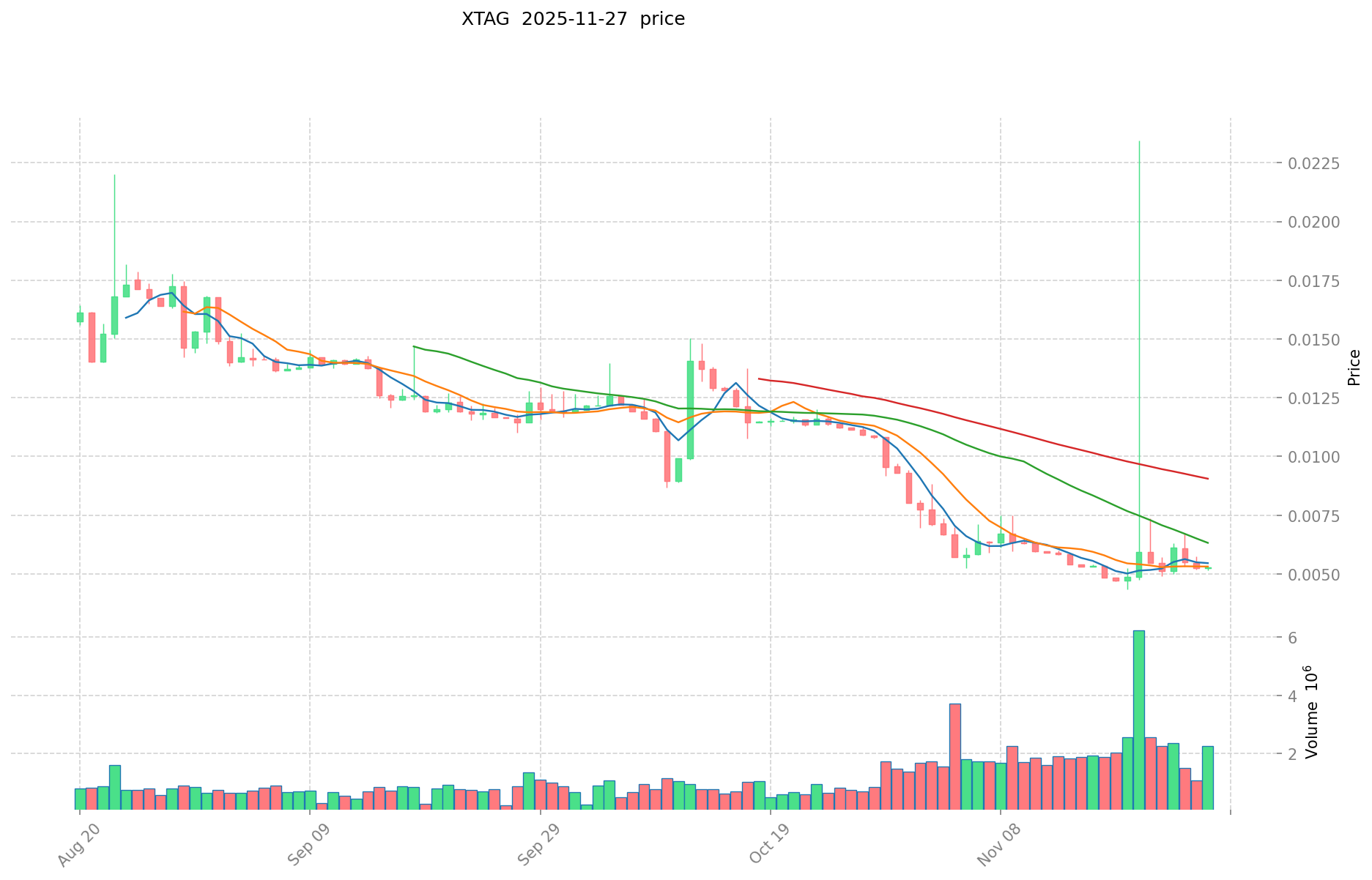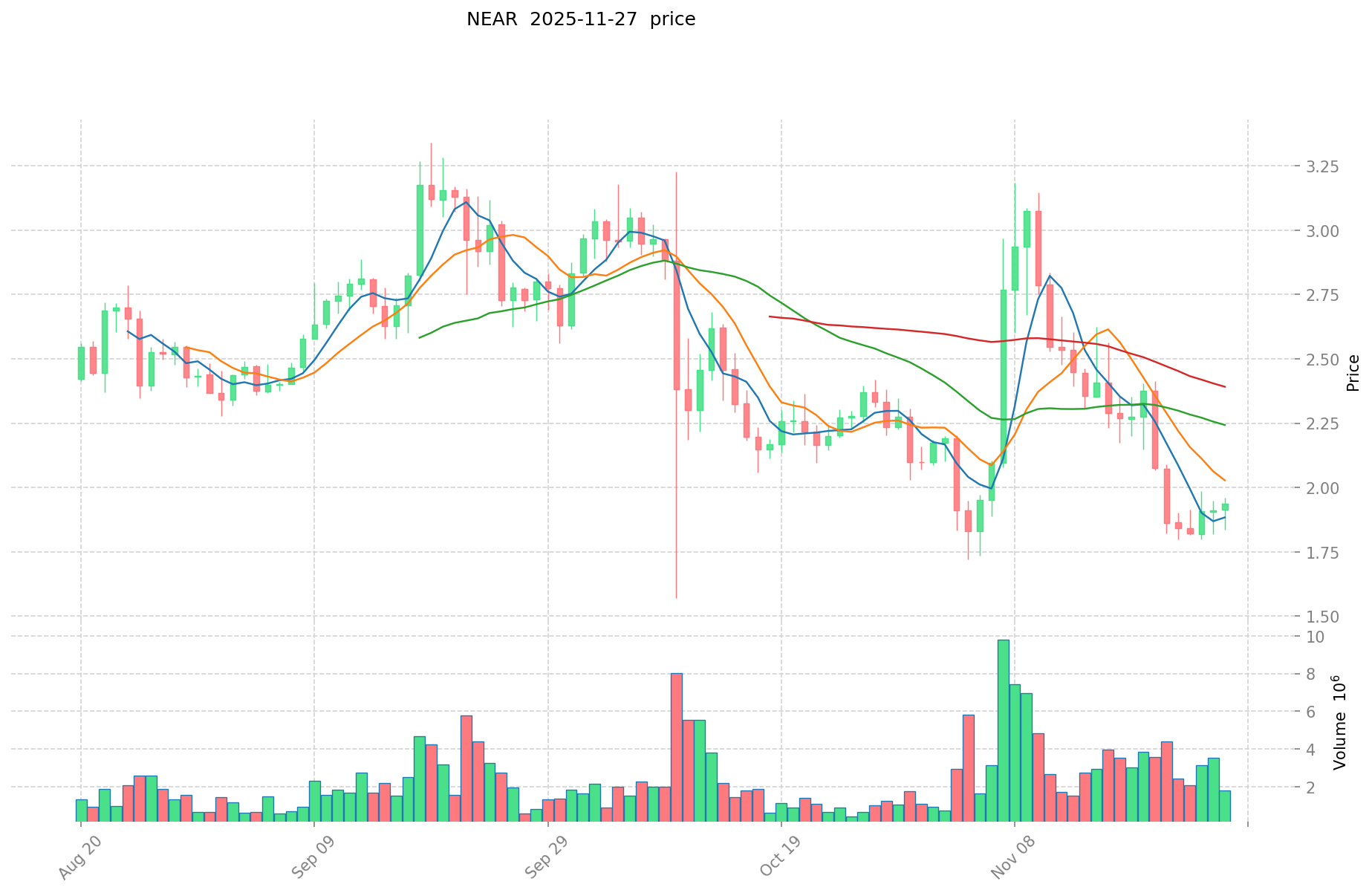XTAG vs NEAR: Comparing Two Blockchain Ecosystems for Decentralized Applications
Introduction: Investment Comparison of XTAG vs NEAR
In the cryptocurrency market, the comparison between XTAG vs NEAR has always been a topic that investors cannot avoid. The two not only have significant differences in market cap ranking, application scenarios, and price performance, but also represent different positions in crypto assets.
XTAG (XTAG): Since its launch, it has gained market recognition for its role in building, managing, and deploying decentralized AI agents.
NEAR (NEAR): Since its inception, it has been hailed as a highly scalable base protocol ensuring fast support for DApp operations on mobile devices, and is one of the cryptocurrencies with high global trading volume and market capitalization.
This article will comprehensively analyze the investment value comparison between XTAG vs NEAR, focusing on historical price trends, supply mechanisms, institutional adoption, technological ecosystems, and future predictions, and attempt to answer the question that investors care most about:
"Which is the better buy right now?"
I. Price History Comparison and Current Market Status
XTAG (Coin A) and NEAR (Coin B) Historical Price Trends
-
2021: NEAR reached its all-time high of $20.44 on January 17, 2022, during the broader crypto market bull run.
-
2025: XTAG hit its all-time low of $0.00449842 on November 19, 2025, indicating a significant price decline.
-
Comparative Analysis: In the current market cycle, XTAG has dropped from its all-time high of $4.52 to a current price of $0.00543, while NEAR has fallen from its peak of $20.44 to $1.928.
Current Market Situation (2025-11-27)
- XTAG current price: $0.00543
- NEAR current price: $1.928
- 24-hour trading volume: XTAG $11,793.25 vs NEAR $2,013,916.01
- Market Sentiment Index (Fear & Greed Index): 22 (Extreme Fear)
Click to view real-time prices:
- Check XTAG current price Market Price
- Check NEAR current price Market Price


II. Key Factors Affecting XTAG vs NEAR Investment Value
Supply Mechanism Comparison (Tokenomics)
- XTAG: Initial supply of 1 billion tokens with a deflationary mechanism through buyback and burn
- NEAR: Total supply of 1 billion tokens with a gradual release schedule and inflation rate of 5% annually
- 📌 Historical Pattern: Deflationary models like XTAG's tend to support price appreciation if demand remains consistent, while NEAR's controlled inflation requires growing adoption to maintain token value.
Institutional Adoption and Market Applications
- Institutional Holdings: NEAR has secured more institutional backing with investments from major funds like Andreessen Horowitz and Coinbase Ventures
- Enterprise Adoption: NEAR offers more established enterprise solutions through its Aurora EVM compatibility, while XTAG focuses on gaming and entertainment sectors
- Regulatory Attitudes: Both tokens face similar regulatory scrutiny, though NEAR's foundation-based structure provides more regulatory clarity in multiple jurisdictions
Technical Development and Ecosystem Building
- XTAG Technical Upgrades: Integration with XY Finance for cross-chain swaps and implementation of dynamic NFT technology
- NEAR Technical Development: Sharding implementation for scalability and the development of NEAR BOS (Blockchain Operating System)
- Ecosystem Comparison: NEAR has a more diverse ecosystem spanning DeFi, NFTs, and DAOs with projects like Ref Finance and Paras NFT marketplace, while XTAG focuses on gaming, metaverse applications, and entertainment platforms
Macroeconomic Factors and Market Cycles
- Performance During Inflation: NEAR has shown better resilience during inflationary periods due to its more established market presence
- Monetary Policy Impact: Both tokens show sensitivity to Federal Reserve policy changes, with NEAR demonstrating slightly more correlation to traditional markets
- Geopolitical Factors: NEAR's decentralized development teams across multiple regions provide better insulation from regional regulatory risks
III. 2025-2030 Price Prediction: XTAG vs NEAR
Short-term Prediction (2025)
- XTAG: Conservative $0.00352 - $0.00541 | Optimistic $0.00541 - $0.00611
- NEAR: Conservative $1.69 - $1.92 | Optimistic $1.92 - $2.48
Mid-term Prediction (2027)
- XTAG may enter a growth phase, with an estimated price range of $0.00575 - $0.00794
- NEAR may enter a bullish market, with an estimated price range of $1.78 - $3.24
- Key drivers: Institutional capital inflow, ETF, ecosystem development
Long-term Prediction (2030)
- XTAG: Base scenario $0.00563 - $0.00782 | Optimistic scenario $0.00782 - $0.00868
- NEAR: Base scenario $2.55 - $3.11 | Optimistic scenario $3.11 - $3.23
Disclaimer: The above predictions are based on historical data and market analysis. Cryptocurrency markets are highly volatile and subject to rapid changes. These projections should not be considered as financial advice. Always conduct your own research before making investment decisions.
XTAG:
| 年份 | 预测最高价 | 预测平均价格 | 预测最低价 | 涨跌幅 |
|---|---|---|---|---|
| 2025 | 0.0061133 | 0.00541 | 0.0035165 | 0 |
| 2026 | 0.0067411305 | 0.00576165 | 0.0032841405 | 6 |
| 2027 | 0.0079392656175 | 0.00625139025 | 0.00575127903 | 15 |
| 2028 | 0.007733907447787 | 0.00709532793375 | 0.00652770169905 | 30 |
| 2029 | 0.008230225636753 | 0.007414617690768 | 0.006524863567876 | 36 |
| 2030 | 0.008682888046774 | 0.007822421663761 | 0.005632143597907 | 44 |
NEAR:
| 年份 | 预测最高价 | 预测平均价格 | 预测最低价 | 涨跌幅 |
|---|---|---|---|---|
| 2025 | 2.48067 | 1.923 | 1.69224 | 0 |
| 2026 | 3.10458735 | 2.201835 | 2.13577995 | 14 |
| 2027 | 3.2369176335 | 2.653211175 | 1.77765148725 | 37 |
| 2028 | 3.0334163363775 | 2.94506440425 | 1.825939930635 | 52 |
| 2029 | 3.22837959993885 | 2.98924037031375 | 2.899563159204337 | 55 |
| 2030 | 3.233162384531352 | 3.1088099851263 | 2.549224187803566 | 61 |
IV. Investment Strategy Comparison: XTAG vs NEAR
Long-term vs Short-term Investment Strategy
- XTAG: Suitable for investors interested in AI, gaming, and metaverse potential
- NEAR: Suitable for investors seeking ecosystem growth and scalability solutions
Risk Management and Asset Allocation
- Conservative investors: XTAG: 10% vs NEAR: 90%
- Aggressive investors: XTAG: 30% vs NEAR: 70%
- Hedging tools: Stablecoin allocation, options, cross-currency portfolios
V. Potential Risk Comparison
Market Risk
- XTAG: Higher volatility due to lower market cap and trading volume
- NEAR: Susceptible to broader crypto market trends and competition from other Layer 1 protocols
Technical Risk
- XTAG: Scalability, network stability
- NEAR: Sharding implementation challenges, potential security vulnerabilities
Regulatory Risk
- Global regulatory policies may impact both, with NEAR potentially facing less scrutiny due to its more established foundation structure
VI. Conclusion: Which Is the Better Buy?
📌 Investment Value Summary:
- XTAG advantages: Potential for growth in AI and gaming sectors, deflationary tokenomics
- NEAR advantages: Established ecosystem, institutional backing, scalability solutions
✅ Investment Advice:
- New investors: Consider a higher allocation to NEAR for its established market presence
- Experienced investors: Balanced approach with a tilt towards NEAR, while maintaining exposure to XTAG's growth potential
- Institutional investors: Focus on NEAR for its regulatory clarity and ecosystem development
⚠️ Risk Warning: The cryptocurrency market is highly volatile. This article does not constitute investment advice. None
FAQ
Q1: What are the key differences between XTAG and NEAR? A: XTAG focuses on AI, gaming, and metaverse applications with a deflationary token model, while NEAR is a scalable Layer 1 protocol with a more diverse ecosystem and controlled inflation. NEAR has higher trading volume, market cap, and institutional backing compared to XTAG.
Q2: Which token has shown better price performance historically? A: NEAR has demonstrated better historical price performance, reaching an all-time high of $20.44 in January 2022. XTAG, on the other hand, has experienced a significant price decline, with its all-time low of $0.00449842 in November 2025.
Q3: How do the supply mechanisms of XTAG and NEAR compare? A: XTAG has an initial supply of 1 billion tokens with a deflationary mechanism through buyback and burn. NEAR has a total supply of 1 billion tokens with a gradual release schedule and an inflation rate of 5% annually.
Q4: What are the main factors affecting the investment value of XTAG and NEAR? A: Key factors include supply mechanisms, institutional adoption, market applications, technical development, ecosystem building, macroeconomic factors, and market cycles. NEAR generally has advantages in most of these areas due to its more established presence and diverse ecosystem.
Q5: What are the price predictions for XTAG and NEAR in the short and long term? A: For 2025, XTAG is predicted to range from $0.00352 to $0.00611, while NEAR is expected to range from $1.69 to $2.48. By 2030, XTAG's optimistic scenario predicts $0.00782 to $0.00868, while NEAR's optimistic scenario predicts $3.11 to $3.23.
Q6: How should investors allocate their assets between XTAG and NEAR? A: Conservative investors might consider allocating 10% to XTAG and 90% to NEAR, while aggressive investors might allocate 30% to XTAG and 70% to NEAR. The specific allocation should be based on individual risk tolerance and investment goals.
Q7: What are the potential risks associated with investing in XTAG and NEAR? A: Both tokens face market risks, technical risks, and regulatory risks. XTAG has higher volatility due to its lower market cap and trading volume, while NEAR is more susceptible to broader crypto market trends and competition from other Layer 1 protocols. Regulatory risks may impact both, with NEAR potentially facing less scrutiny due to its more established foundation structure.
Share
Content